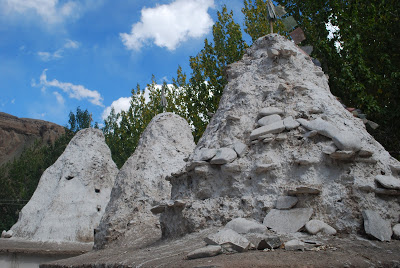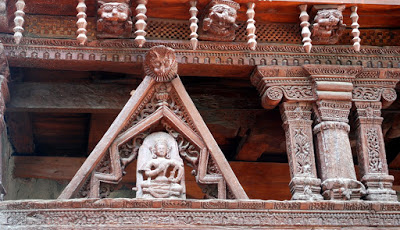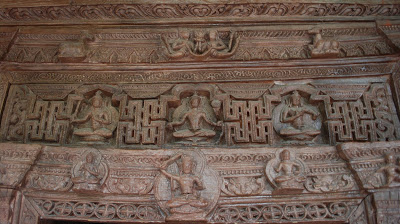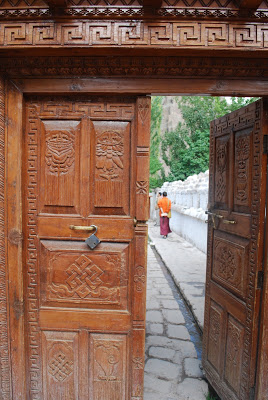Alchi – an Inside story
Its been more than a year since I started writing my column Inside Story for the Metro Plus, a supplement of The Hindu . The column which appears every alternate Monday is not a destination piece nor is it a personalised travelogue. It is a story that is intrinsic to the destination or an aspect of the destination that is not normally experienced by an average tourist . Sometimes the stories lend themselves to people, for it is people who make places. Ive written quite a few Inside Stories and yet have posted very few in my blog. So I thought of posting some of my earlier published stories here. This one is about Alchi, the most ancient Gompa in Ladakh which was published last Monday .
As you drive down Ladakh, you see several monasteries or Gompas hanging silently from a cliff or sloping down from a peak. They often look like fortresses with prayer wheels and mani walls built around them. But Alchi is a bit different from the rest. Lying in a village of the Indus valley on a plain, this ancient gompa is neither imposing nor is it full of life. 
For a first timer , it is just another sleepy hamlet with a few random houses thrown in, a lone shop selling artifacts and a couple of lamas sitting under an apricot grove exchanging conversations. And hidden amongst these silent houses is the oldest monastery of Ladakh which houses some of the most unique paintings . 
The monastery lies in the chos khor or monastic complex of four separate monuments, and is deemed to be very different from the rest in terms of architecture and monastic order. The Gompa nestled in a courtyard is connected by narrow alleys that lead to several small shrines with wooden pillars and walls that brightly display paintings like the Thousand Buddhas and the wheel of life. Looking at every wall with a torch, these paintings do not look like the typical Ladakhi images as we see in the other monasteries . 
Inspired by the Kashmiri tradition, the monastery complex was built, by Guru Rinchen Zangpo around 10th century. However, according to the inscriptions ,it is attributed to a Tibetan noble called Kal-dan Shes-rab who is said to have built it in the next century. 
A fusion of the artistic and spiritual aspect of both Hinduism and Buddhism is seen in the wall paintings of this monastery while the Kashmiri style is also seen in the Dukhang or assembly hall and the main temple , Sumstek which is a three storied dedicated to the three incarnations of Buddha – Avalokiteshwara, Maitreya and Manjushree. We cannot see the heads of these deities as they stand in the first floor and there is no access to reach there . 
The monastery which was discarded as a religious order actually escaped the invasion of Ladakh by Ali Mir, a ruler from Baltistan in the17th century, a war that almost brought Buddhism to an end in Ladakh. While the king Jamyang was taken prisoner, a popular legend says that he was restored his throne after a secret marriage with one of Ali Mir’s daughter , Gyal katun. While historians refute the story, the legend says ladakhis even accepted the new queen as an incarnation of the White Tara. 
However ,legends not withstanding, Buddhism flourished in ladakh and more monasteries were built, but it was much later in 1970s the unique paintings were discovered in Alchi, a village that had been ignored for centuries. A lone lama sits guard in front of the main Gompa holding on to his prayer wheel . A Gompa means a solitary place and as I walk past it, I realize the true meaning of solitude .

hey, all these pics werent on the article, were they??? was it edited there?? but nice one… and looking forward to reading more of your Hindu Articles….. we dont get the paper regularly, so would love to catch them here…
Ladakh – always a place to visit.
Good blog post. India is a good for vacation holiday with lots of places where can visit for Wildlife and Historical tour.
Good one…I will keep looking for the Inside story on the Hindu.
peace.. that’s my first thought..
Thanks for this post, it’s useful for me
but about travelling to south america, it’s also great 😉
__________________
Latino Guy
Latino Portal
Anu – Hindu normally publishes a pic or two..so, I have added more here..will post some of my old stories as well
Hobo – I agree
BTO – Thanks
Ajeya – Thank you..i will add some posts here as well
Yuva – Yes, its so quiet and peaceful
Khmessenger – Thanks for visitg my blog
I read this article in the Hindu, and also your other articles. Its always a great pleasure to read and book mark for me to visit later. Ladhak is one such place I long to go. Keep writing…
Here I see more pictures of alchi than your column in metroplus. The last one is like welcoming to peace.
Wow!
I have to catch up with lot many things on your blog. Good to be back here again :). Thank you so much for the beautiful posts!
I’m always fascinated about the different Gompas of Leh, Ladakh.